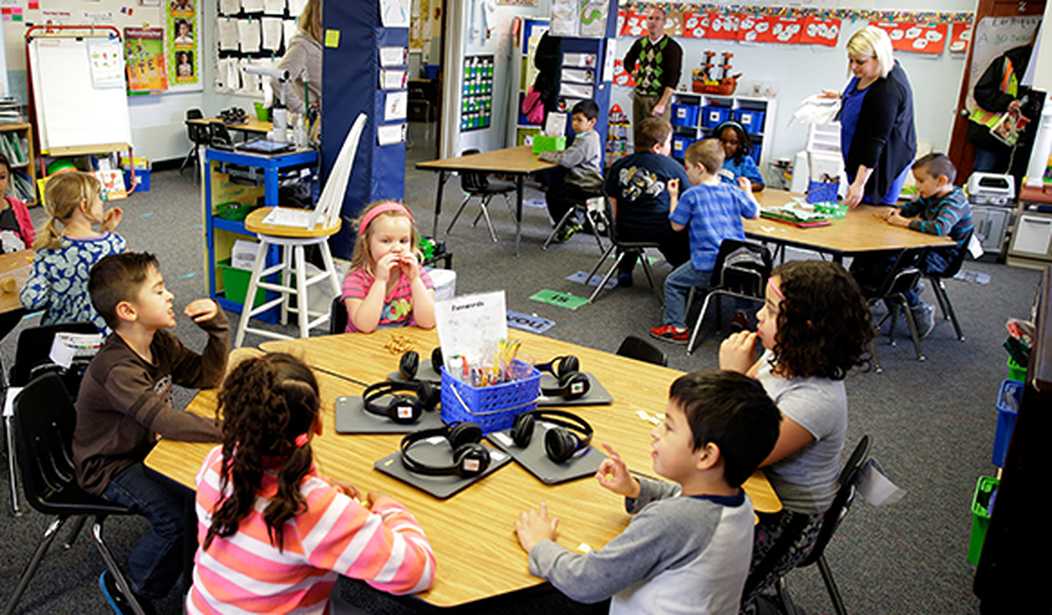In Minnesota, they’re rethinking social studies.
Not long ago, schools largely taught dry facts. These days, institutions are soaked — with perspective (see “Virginia School Video Tells 2nd Graders a Key to Feeling Safe Is Zero Police“). Education appears aimed at creating right-thinking citizens rather than academically-informed students.
Apropos of that, the state’s Department of Education will meet Tuesday to review proposed protocols.
As noted by Campus Reform, the plan was composed by a committee including professors from five colleges:
- University of Minnesota, Twin Cities
- Macalester College
- University of St. Thomas
- Bethel University
- St. Catherine University
The K-12 social studies standards depict national history in an evolved way: in part, through the lens of “power structures” and “systems of oppressions [sic].”
“The academic standards and their supporting benchmarks,” the document reads, “are organized into five strands: Citizenship and Government, Economics, Geography, U.S. and World History, and Ethnic Studies.
Tribes would be treated robustly:
The contributions of Minnesota’s American Indian tribes and communities are integrated into each strand and all standards. Each of the strands have between three and six standards.
The plan lays out “benchmarks,” which “[supplement] the standard and [are] the specific knowledge and/or skill that a student must master to meet part of an academic standard by the end of a grade level or grade band.”
A few on order for ninth graders:
- Describe the origins and spread of the transatlantic abolition movement, centering the role of Black abolitionists, and compare historical abolition to abolitionist movements today.
- Explore how criminality is constructed and what makes a person a criminal.
- Develop a respectful awareness about how ideas and norms about gender have changed over time, and how members of the LGBTQ+ community have responded to persecution or marginalization by building coalitions to promote gender equality/equity.
A standard for grade nine:
Use historical methods and sources, inclusive of ethnic and Indigenous studies methods and sources, to understand and reflect upon the roots of contemporary social systems and environmental systems of oppressions and apply lessons from the past to eliminate injustice and work toward an equitable future.
If the criteria are accepted, young Minnesotans will be schooled on balance, and not at the seesaw.
For kindergarteners:
Tell a story about a fair and unfair experience that illustrates power balances and imbalances.
Courtesy of the corresponding standard:
Use historical methods and sources, inclusive of ethnic and Indigenous studies methods and sources, in order to understand and reflect upon the roots of contemporary social systems and environmental systems of oppressions and apply lessons from the past to eliminate injustice and work toward an equitable future.
A first grade benchmark:
Construct meaning of the terms ethnicity, equality, liberation and systems of power and identify examples.
And a standard for six-year-olds:
Describe places and regions, explaining how they are influenced by power structures.
As of late, power — the division between oppression and victimization — is what understanding America is all about.
In the late 80s, kids looked up to He-Man — he “had the power.” Little boys imagined they were he because they believed they could be immensely strong. And they were encouraged due to power being a positive thing.
These days, “empowered” is hailed, but seemingly only for select citizens. Power, anymore, is the manifestation of privilege — a source of shame.
Will The North Star State’s proposed standards — set for effect in 2025 — be implemented?
While we wait to find out, consider an eighth-grade test from 1912 — covering math, grammar, geography, physiology, government, and history.
Put against Minnesota’s current considerations — in terms of benefit and complexity — how would you say the curricula might compare?
- Write in words the following: 5764; .000003; .123416; 653.0965; 43.37.
- Find the amount of $50.30 for 3 years, 3 months, and 3 days, at 8%.
- Find cost at 12 1/2 cents per sq. yd. of kalsomining the walls of a room 20 ft. long, 16 ft. wide and 9 ft. high, deducting 1 door 8 ft. by 4 ft. 6 in. and 2 windows 5 ft. by 3 ft. 6 in. each.
- A school enrolled 120 pupils, and the number of boys was two-thirds of the number of girls. How many of each sex were enrolled?
- At $1.62 1/2 a cord, what will be the cost of a pile of wood 24 ft. long, 4 ft. wide and 6 ft. 3 in. high?
- How many parts of speech are there? Define each.
- “William struck James.” Change the Voice of the verb.
- Adjectives have how many Degrees of Comparison? Compare good; wise; beautiful.
- Diagram: The Lord loveth a cheerful giver.
- Parse all the words in the following sentences: John ran over the bridge. Helen’s parents love her.
- Define longitude and latitude.
- Name and give boundaries of the five zones.
- Name and give the capitals of the States touching the Ohio River.
- How does the liver compare in size with other glands in the human body? Where is it located? What does it secrete?
- Compare arteries and veins as to function. Where is the blood carried to be purified?
- Define the following forms of government: Democracy, Limited Monarchy, Absolute Monarchy, Republic. Give examples of each.
- To what four governments are students in school subjected?
- Name three rights given Congress by the Constitution and two rights denied Congress.
- Who first discovered the following places — Florida, Pacific Ocean, Mississippi River, St. Lawrence River?
- Sketch briefly Sir Walter Raleigh, Peter Stuyvesant.
- Name the last battle of the Civil War; War of 1812; French and Indian War; and the commanders in each battle.
-ALEX
See more pieces from me:
Not Hollywood: Kirstie Alley Joins the Chorus Against Erasing Women
More Than 160 Minnesota Principals Plot to ‘De-Center Whiteness’
Iranian Immigrant Kabobs Public Ed’s ‘Garbage Ideology’: It’s ‘Making Our Kids Dumber’
Find all my RedState work here.
Thank you for reading! Please sound off in the Comments section below.














Join the conversation as a VIP Member